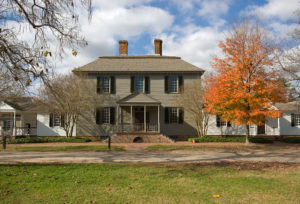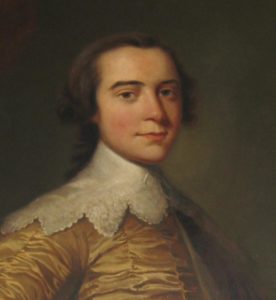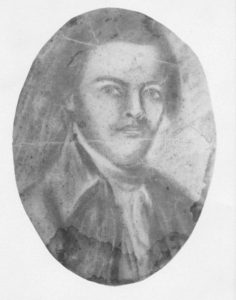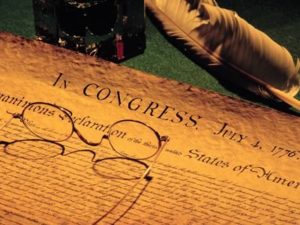Of the eighty-eight structures at the recreated historic Colonial Williamsburg, most are homes. In colonial America, the home extended a form of trade and business to the community as a part of its mission. Children were taught trades at a young age. The home was the first church where worship and prayer took place. It was also the first system of economics where children would learn the values of stewarding goods and money. Furthermore, it was the first civil government where justice would be applied and the first foreign policy where strangers would be entertained. So it was at the Robert Carter III home pictured here in Williamsburg.
 There are many lessons to learn from the Carter household. John Carter, the great grandfather of Robert III came to Virginia at 22 in 1635. He served in the House of Burgesses and helped build Christ Church. In spite of his religious values, he became a leader in acquiring slaves or “tithables” as they were called. He owned more slaves than anyone in Virginia by the time he died in 1669. John’s son Robert, grandfather of Robert III also served in the House of Burgesses in 1691, as Speaker of the House in 1696, and on the Governor’s Council in 1700. In addition to his public service he was the second wealthiest individual in Virginia by 1726, owning 300,000 acres, 47 plantations, 18 buildings, and a brick mansion with 15 children from three different wives. Though he taught his children to dream big, unfortunately this meant owning more than 700 slaves and selling thousands more!
There are many lessons to learn from the Carter household. John Carter, the great grandfather of Robert III came to Virginia at 22 in 1635. He served in the House of Burgesses and helped build Christ Church. In spite of his religious values, he became a leader in acquiring slaves or “tithables” as they were called. He owned more slaves than anyone in Virginia by the time he died in 1669. John’s son Robert, grandfather of Robert III also served in the House of Burgesses in 1691, as Speaker of the House in 1696, and on the Governor’s Council in 1700. In addition to his public service he was the second wealthiest individual in Virginia by 1726, owning 300,000 acres, 47 plantations, 18 buildings, and a brick mansion with 15 children from three different wives. Though he taught his children to dream big, unfortunately this meant owning more than 700 slaves and selling thousands more!
 By the time Robert junior grew up, the name of “Carter” was not popular. A family that owned and sold more slaves than anyone else was reviled. Robert II died at 29 in 1732. His father Robert I, known as “King” Carter, also died the same year, thus 4 year old Robert III lost his father and grandfather in the same year; but had been given his first slave at age 3! He attended the Grammar school at William and Mary at age 9 and by 11 he inherited more than 100 slaves and 65,000 acres of land. In 1749, at the age of 21, he sailed to England on a ship with Lawrence, half-brother of George Washington. This would eventually bring him into a relationship with some of the most ardent patriots. A greater Providence was that it brought him into contact with their faith as well.
By the time Robert junior grew up, the name of “Carter” was not popular. A family that owned and sold more slaves than anyone else was reviled. Robert II died at 29 in 1732. His father Robert I, known as “King” Carter, also died the same year, thus 4 year old Robert III lost his father and grandfather in the same year; but had been given his first slave at age 3! He attended the Grammar school at William and Mary at age 9 and by 11 he inherited more than 100 slaves and 65,000 acres of land. In 1749, at the age of 21, he sailed to England on a ship with Lawrence, half-brother of George Washington. This would eventually bring him into a relationship with some of the most ardent patriots. A greater Providence was that it brought him into contact with their faith as well.
In 1754, after his return, Robert III married Frances Ann Tasker, daughter of the former Governor of Maryland. Within 18 years they had 17 children though only 12 would live to adulthood. Robert was part of the Governor’s Council and by 1761 moved his growing family to Williamsburg where he purchased a home adjacent to the Governor’s Palace and next to George Wythe. In the next decade Robert would be influenced by Governor Faquier, John Blair and a young Thomas Jefferson studying law next door at the Wythe house. These influences would make Robert a patriot by the time of the Revolution. He renounced his allegiance to George III, resisted Governor Dunmore, sent supplies to the Virginia militia and refused to have his children taught at William and Mary. He moved his family to Nomini (on the Potomac) in 1772 and hired Philip Fithian to tutor his children.
 Fithian was recommended by Dr. Witherspoon, who was one of his instructors at the College of New Jersey. Converted at a revival in 1766, his faith had a profound impact upon Robert and Anne as well as the children he tutored. Philip would have long discussions with the Carters, and quite often slavery and its abolition would be the topic. Slowly Robert began to see that the true and sincere faith of Christianity was incompatible with the institution of slavery, for all were created equal. Also, Robert’s best boyhood friend had been “Baptist” Billy, 17 years his senior, a converted slave. Fithian’s Journal and Letters provide one of the best glimpses into a colonial home and its practices of education available for us today.
Fithian was recommended by Dr. Witherspoon, who was one of his instructors at the College of New Jersey. Converted at a revival in 1766, his faith had a profound impact upon Robert and Anne as well as the children he tutored. Philip would have long discussions with the Carters, and quite often slavery and its abolition would be the topic. Slowly Robert began to see that the true and sincere faith of Christianity was incompatible with the institution of slavery, for all were created equal. Also, Robert’s best boyhood friend had been “Baptist” Billy, 17 years his senior, a converted slave. Fithian’s Journal and Letters provide one of the best glimpses into a colonial home and its practices of education available for us today.
 Though Robert’s great grandfather had freed his slaves in his will upon his death, the practice of manumission was illegal in Virginia from 1728 to 1783. The turning point for Robert III was none other than the drafting and ratification of the Declaration of Independence in 1776. By the “laws of nature and of nature’s God” all men were created equal. They were given these rights by their Creator and not the government. Furthermore, all governments ought to operate on the basis of self-rule, securing and protecting rights. Since Christianity and the Bible taught these truths, he was convinced that he must be converted. No sect was more adamant for the abolition of slavery at the time than the Baptists. Carter joined the Morattico Baptist Church, declaring his faith openly in their meetings.
Though Robert’s great grandfather had freed his slaves in his will upon his death, the practice of manumission was illegal in Virginia from 1728 to 1783. The turning point for Robert III was none other than the drafting and ratification of the Declaration of Independence in 1776. By the “laws of nature and of nature’s God” all men were created equal. They were given these rights by their Creator and not the government. Furthermore, all governments ought to operate on the basis of self-rule, securing and protecting rights. Since Christianity and the Bible taught these truths, he was convinced that he must be converted. No sect was more adamant for the abolition of slavery at the time than the Baptists. Carter joined the Morattico Baptist Church, declaring his faith openly in their meetings.
Carter would later recall that his “religious conversion” occurred at the time of the Declaration, and his “political conversion” occurred at the time of the ratification of the United States Constitution. Indeed it is the Declaration that declares the truths, drawn from the Bible, by which our nation was born. It is also true that the Constitution, ratified thirteen years later in 1789, secured the due process of protecting equality, both religious and civil. What happened next has been lost to history, for Robert Carter III is the Founding Father of Emancipation that freed more slaves than any other individual prior to 1860. He was “determined to end slavery.” He began with what he called his Deed of Gift.
To illustrate his religious conversion and break the generational cycle of slavery in his family, he erected a large pulpit in front of his home and announced the freedom of his 452 slaves in 1791: ”I have for some time past been convinced that to retain them in slavery is contrary to the true Principles of Religion and Justice, and that therefore it was my Duty to manumit them.” Carter implemented an immediate yet gradual emancipation. It was immediate, yet gradual, for by their choice they could remain as employees in order to become self-sufficient. This was true love for their independence and productivity. As late as 1852, Julia Carter, Robert III’s daughter, was still freeing descendants of Carter’s slaves under the same Deed of Gift. Truly Robert Carter is a fascinating Founding Father that has been forgotten in today’s revisionist history, for it was better to be a slave in 1790, closer to the Declaration when its truths were fresh on people’s minds than even in 1810 when the love of money would cause owners to cling to slavery as the Declaration’s truths of equality faded into the background.
This is truly a legacy of the Biblical truth of equality in the Declaration, for it was ahead of tis time! What a blessing to be in a nation founded on the truth of Christianity that promises hope to all the inequities of sin! Biblical promises can be claimed, and thus, as Martin Luther King Jr. declared years later, it was a promissory note that served as an ideal of equality to future generations!







